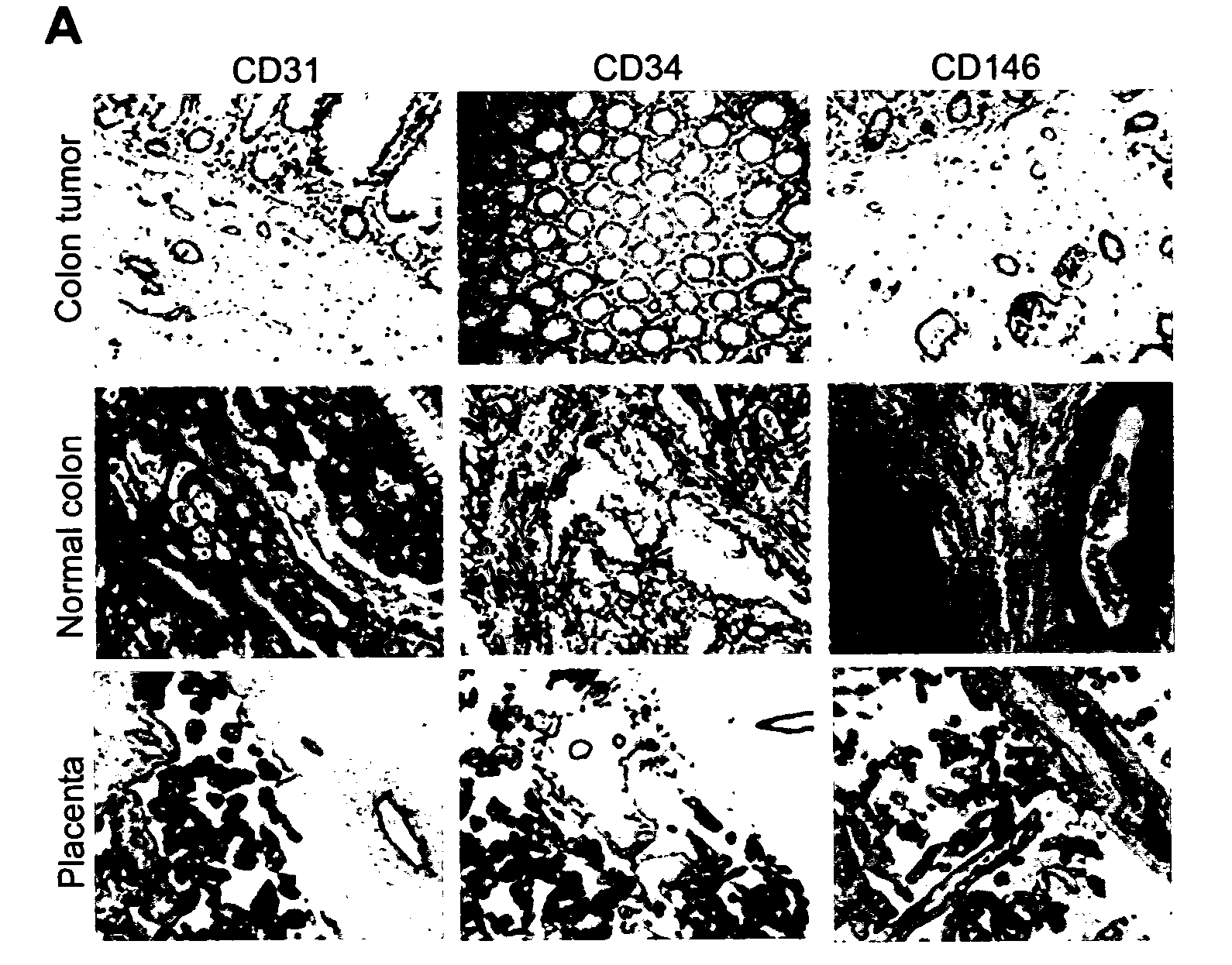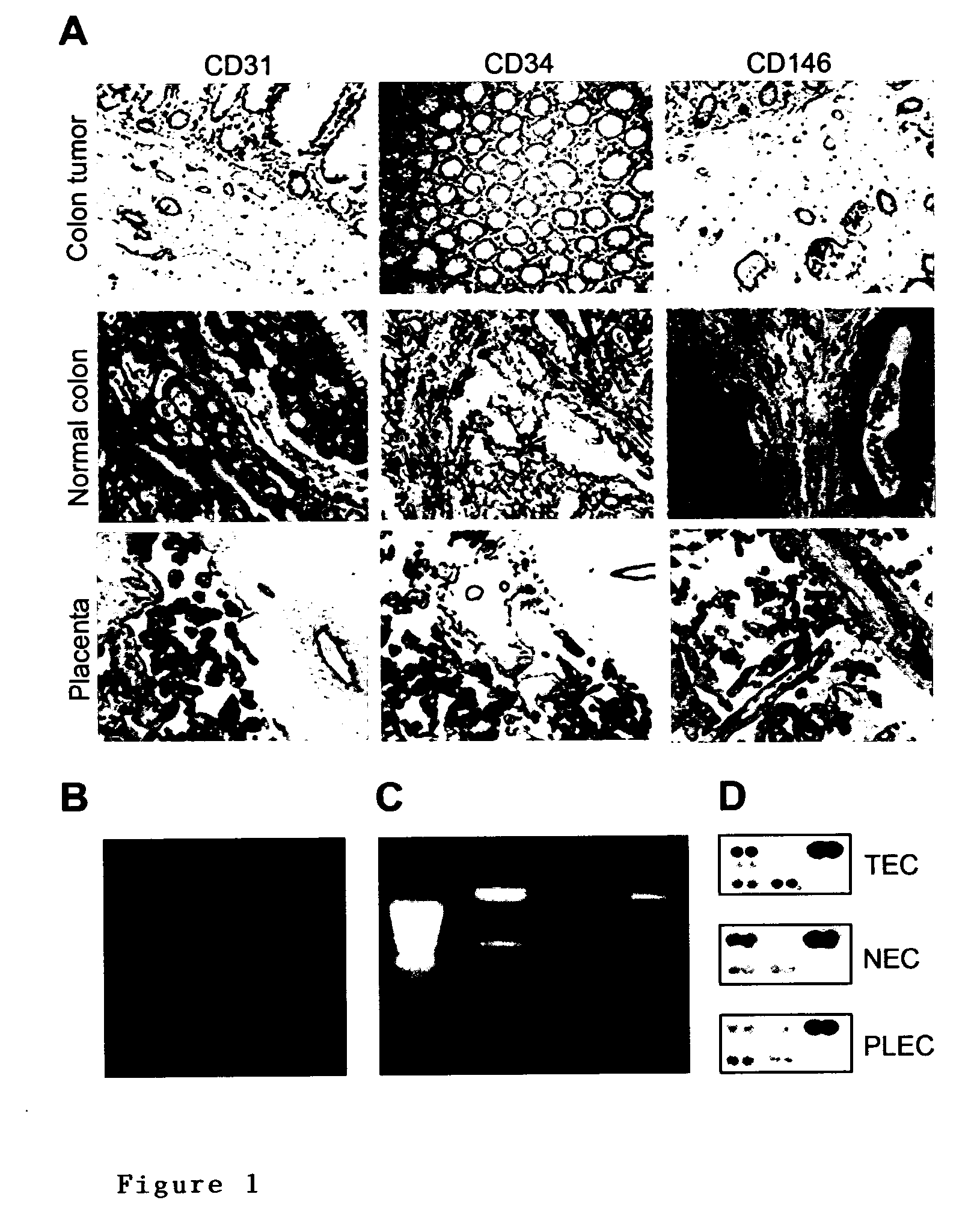Tumor angiogenesis associated genes and a method for their identification
- Summary
- Abstract
- Description
- Claims
- Application Information
AI Technical Summary
Benefits of technology
Problems solved by technology
Method used
Image
Examples
example 1 experimental procedures
1.1 Isolation of Endothelial Cells from Fresh Tissues
[0254]Fresh colorectal tumors (Dukes C) (n=5) and distant normal colon tissues of the same patient (n=5) were obtained from excision surgery at the department of Pathology (University Hospital Maastricht). Fresh placenta tissues (n=5) were obtained from the department of Obstetrics (University Hospital Maastricht). Endothelial cells were isolated as previously described (St Croix et al., 2000), with minor modifications. Tissues were minced with surgical blades, digested for 30 minutes with 1 mg / ml collagenase (Life Technologies, Breda, The Netherlands) and 2.5 U / ml dispase (Life Technologies) at 37° C. with continuous agitation. DNAse I (Sigma, Zwijndrecht, The Netherlands) was added to a final concentration of 100 μg / ml and the cell suspension was incubated for another 30 minutes prior to Ficoll Paque gradient density centrifugation (Amersham Biosciences, Uppsala, Sweden).
[0255]Endothelial cells were stained with anti-CD31 (clone...
example 2
Identification of Tumor Endothelial Markers by SSH
[0278]A suppression subtractive hybridization (SSH) was performed in combination with cDNA array screening to identify novel tumor specific endothelial markers in an unbiased manner. Tumor endothelial cells (TEC) were successfully isolated from colon tumors (n=5) and patient-matched normal endothelial cells (NEC) from normal colon tissue samples (n=5), as well as from placenta tissues (PLEC, n=5) (FIG. 1). RNA was isolated (FIG. 1) and used to create subtraction repertoires of genes overexpressed in TEC. In addition, HUVEC were stimulated in vitro with tumor cell conditioned medium and used to create additional subtraction repertoires. A total of 2746 inserts, 1781 derived from the TEC subtractions and 965 derived from the HUVEC subtractions were amplified and spotted onto duplicate arrays that were probed with 33P-dCTP labeled cDNA derived from TEC, NEC, PLEC and HUVEC. Phospho-imaging and pair-wise comparisons of spot intensities w...
example 3
Gene Expression of Tumor Endothelial Cells is Closely Related to Gene Expression During Physiological Angiogenesis
[0281]It emerged that the majority of TEC overexpressed transcripts ( 85 / 142=60%) are also associated with angiogenesis under physiological conditions in vivo, and are therefore not specific for tumor angiogenesis in vivo (FIG. 2B). These 85 GAG / A transcripts represent 46 different genes, including genes that have been associated with angiogenesis such as matrix metalloproteinases (MMPs) (Pepper, 2001), integrin β1 (Senger et al., 2002) and endothelial cell specific molecule-1 (Aitkenhead et al., 2002) (Table 3).
PUM
| Property | Measurement | Unit |
|---|---|---|
| Fraction | aaaaa | aaaaa |
| Fraction | aaaaa | aaaaa |
| Fraction | aaaaa | aaaaa |
Abstract
Description
Claims
Application Information
 Login to View More
Login to View More - R&D
- Intellectual Property
- Life Sciences
- Materials
- Tech Scout
- Unparalleled Data Quality
- Higher Quality Content
- 60% Fewer Hallucinations
Browse by: Latest US Patents, China's latest patents, Technical Efficacy Thesaurus, Application Domain, Technology Topic, Popular Technical Reports.
© 2025 PatSnap. All rights reserved.Legal|Privacy policy|Modern Slavery Act Transparency Statement|Sitemap|About US| Contact US: help@patsnap.com



